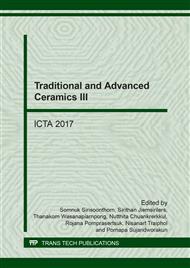[1]
A. Mishra, N. Mishra, S. Bisen, K. M. Jarabana, Frequency and temperature dependent dielectric studies of BaTi0.96Fe0.04O3. J. Ph. 543 (2014) 1-5.
Google Scholar
[2]
R. Rania, S. Singh, J.K. Juneja, K.K. Rainad, H. Prakash, Dielectric properties of Zr substituted BST ceramics. 8. 37 (2011) 3755-3758.
DOI: 10.1016/j.ceramint.2011.03.080
Google Scholar
[3]
J. H. Jeon, Effect of SrTiO3 concentration and sintering temperature on microstructure and dielectric constant of Ba1-xSrxTiO3. J. Eur. Cera. Soc. 24 (2004) 1045-1048.
DOI: 10.1016/s0955-2219(03)00385-6
Google Scholar
[4]
S.W. Kima , H.I. Choia , M.H. Leeb , J.S. Parkb , D.J. Kimb , D. Dob , M.H. Kimb , T.K. Songb, W.J. Kima. Electrical properties and phase of BaTiO3–SrTiO3 solid solution. Ceram. Int. 39 (2013) 487-490.
Google Scholar
[5]
A. Srinivas, R.V. Krishnaiah, V.L. Niranjani, S.V. Kamat, T. Karthik, A. Saket, Ferroelectric, piezoelectric and mechanical prpperties in lead free (0.5)Ba(Zr0.2Ti0.8)O3-(0.5)(Ba0.7Ca0.3)TiO3 electroceramics. Ceram. Int. 41 (2015) 1980-(1985).
DOI: 10.1016/j.ceramint.2014.08.127
Google Scholar
[6]
P. Sateesh, J. Omprakash, G.S. Kumar, G. Prasad, Studies of phase transition and impedance behavior of Ba(Zr,Ti)O3 Ceramics, J. Adv. Diele. 5(1) (2015) 1550002 1-13.
DOI: 10.1142/s2010135x15500022
Google Scholar
[7]
X. Chao, J. wang, P. Liang, T. Zhang, L. Wei, Z. Yang, Phase transition and improved electrical performance of Ba0.85Ca0.15Zr0.1Ti0.9O3-Ca0.28Ba0.72Nb2O6 ceramics with high Curie temperature, Mater. Des. 89 (2016)n465-496.
DOI: 10.1016/j.matdes.2015.10.014
Google Scholar
[8]
Y. Zhang, L. Li, B. Shen and J. Zhai, Effect of orthorhombic-tetraganal phase transition on structure and piezoelectric properties of KNN-base lead -free ceramic. 44 (2015) 7797-7802.
DOI: 10.1039/c5dt00593k
Google Scholar
[9]
W. Li, Z. Xu, R. Chu, H. Zeng, K. Zhao, Enlarged polymorphic phase transition boundary and enhanced piezoelectricity in ternary component 0.8Ba1−xCaxTiO3–0.1BaTi0.8Zr0.2O3–0.1BaTi0.9Sn0.1O3ceramics. 110 (2013) 80-82.
DOI: 10.1016/j.matlet.2013.08.008
Google Scholar
[10]
M. Kamnoy, W. Hiransit, C. Suksri, P. Parjansri, U. Intatha, S. Eitssayeam, Preparation and characterization of (Ba0.85Ca0.15)(Zr0.1Ti0.9)O3 ceramics by a BaTiO3 seed-induced method, J. Nanosci. Nanotech. 16 (2016) 122811-122816.
DOI: 10.1166/jnn.2016.13668
Google Scholar
[11]
R.R. Das, P. Bhattacharya, W. Perez, R.S. Katiyar, Effect of Ca on structural and ferroelectric properties of SrBi2Ta2O9 and SrBi2Nb2O9 thin films, Ceram. Int. 30 (2004) 1175–1179.
DOI: 10.1016/j.ceramint.2004.03.029
Google Scholar
[12]
P.A. Jha, A. K. Jha, Effect of sintering temperature on the grain growth and electrical properties of barium zirconate titanate ferroelectric ceramics, J. Mater Sci. Mater Electron. 24 (2013) 1511–1518.
DOI: 10.1007/s10854-012-0963-7
Google Scholar
[13]
P. Nayak, T. Badapanda, S. Panigrahi, Effect of sintering temperature on electrical properties of SrBi4Ti4O15 ceramics, J. Mater Sci. Mater Electron. 26(2015) 2913–2920.
DOI: 10.1007/s10854-015-2777-x
Google Scholar
[14]
K. Sutjarittangtham, U. Intatha, S. Eitssayeam, Influence of seed nano-crystals on electrical properties and phase transition behaviors of Ba0.85Sr0.15Ti0.90Zr0.10O3 ceramics prepared by seed-induced method, Electron. Mater. Lett. 11(3) (2015).
DOI: 10.1007/s13391-015-4427-0
Google Scholar
[15]
V.S. Puli, D.K. Pradhan, W.Perez, R.S. Katiya, Structure, Dielectric tenability, thermal stability and diffuse phase transiton behavor of lead free BZT-BCT ceramic capacitors. J. Phys. Chem. Solids. 74 (2013) 466-475.
DOI: 10.1016/j.jpcs.2012.11.012
Google Scholar
[16]
P. Sharma, P. Kuma, R.S. Kundu, J.K. Juneja, N. Ahlawat, R. Punia, Structure and dielectric properties of substituted barium titanate ceramics for capacitor applications. Ceram. Int. 41 (2015) 13425-13432.
DOI: 10.1016/j.ceramint.2015.07.131
Google Scholar
[17]
S.W. Kima , H.I. Choia , M.H. Leeb , J.S. Parkb , D.J. Kimb , D. Dob , M.H. Kimb , T.K. Songb, W.J. Kima. 2013. Electrical properties and phase of BaTiO3–SrTiO3 solid solution. Ceram. Int. 39: 487-490.
Google Scholar


